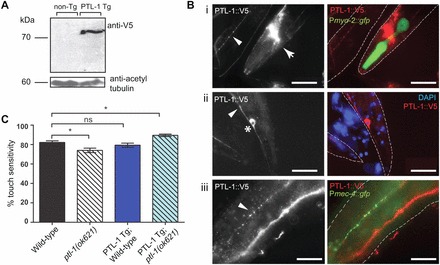Fig. 5.

Re-expression of PTL-1 under the regulation of the ptl-1 promoter can be detected in neurons of transgenic animals and rescues touch sensitivity in a null mutant. ‘PTL-1 Tg’ refers to the PTL-1::V5 transgene; the terms ‘wild-type’ and ‘ptl-1(ok621)’ following this refer to the genotype at the genomic ptl-1 locus, whether wild-type or ok621 mutant, respectively. (A) Immunoblot showing the presence of a band corresponding to PTL-1::V5 expression from the transgene, probed using an anti-V5 antibody. Non-Tg, non-transgenic wild-type animals. (B) Immunofluorescence micrographs showing the expression of the PTL-1::V5 transgene (anti-V5 antibody) in neurons. Grayscale images on the left show the red channel only, the nerve ring is indicated by arrows, axons by arrowheads, and cell bodies by asterisks. (Bi) The pharynx is shown and gfp expression can be observed from the Pmyo-2::gfp transformation reporter. (Bii) A tail neuron is shown with staining in both the cell body and axon. (Biii) Co-localisation with a reporter line for touch receptor neurons (Pmec-4::gfp) is shown, demonstrating that the transgene is expressed in touch neurons. Dotted lines indicate the outline of the animal as determined by phase-contrast microscopy. Ventral is down. Scale bars: 50 µm. (C) Data for sensitivity to gentle touch, shown for PTL-1 transgenic animals (n>45 total for two biological replicates). Control strains are the same as those shown in Fig. 1B. Assays were conducted on 1-day-old adults. Bars indicate mean±s.e.m. One-way ANOVA, Bonferroni post-test; ns, no significance; *P<0.05.
